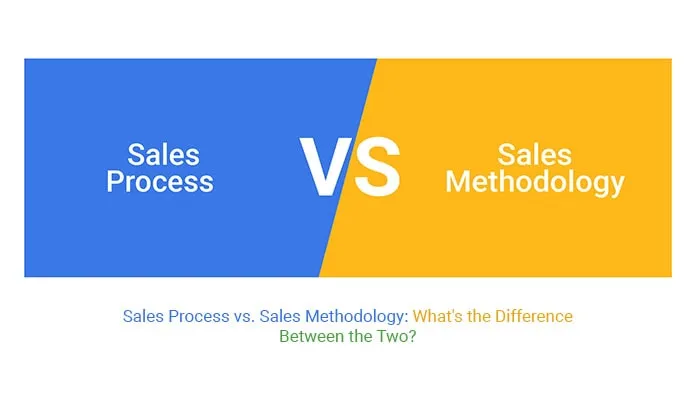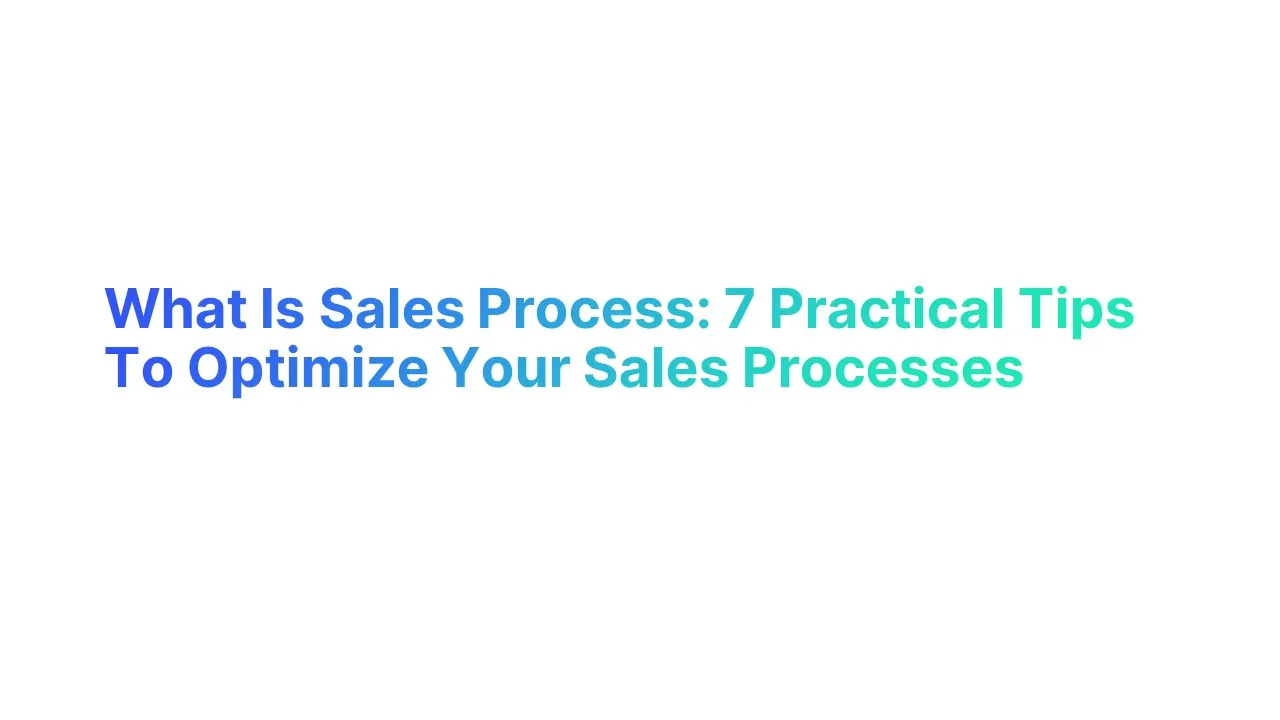Introduction to the Sales Process

What is Sales Process?
A sales process is a set of steps that sales teams follow to turn potential customers into buyers. Each step helps sales reps move closer to closing a deal.
For example, the first step is to find people who might want to buy a product or service. Then, the sales rep contacts these potential customers and learns about their needs. Finally, they offer a solution and close the deal.
A well-designed sales process is important for several reasons:
- Clarity: It helps sales reps understand what they need to do at each step.
- Consistency: It ensures everyone on the sales team follows the same steps.
- Training: It helps new sales reps learn quickly and perform well.
Companies with a defined sales process can see up to a 28% increase in revenue. This is because a clear process helps sales professionals focus on the right activities and avoid wasting time.
Understanding and continuously improving the current sales process is crucial. By analyzing the existing process, identifying inefficiencies, and making necessary adjustments, a sales rep can better qualify leads, meaning they spend time on potential customers who are more likely to buy.
Why Is Sales Process Important for Your Sales Teams

1. Enhanced Efficiency and Productivity
A good sales process helps your sales teams work faster and smarter. When sales reps know exactly what steps to follow, they can spend less time figuring out what to do next.
For example, a clear process can show them how to qualify leads and follow up with potential customers. This means they can focus more on closing deals and less on planning their next move.
- Clarity: Sales reps understand their tasks.
- Speed: Faster decision-making.
- Focus: More time on important activities.
Data shows that teams with a well-defined sales process can improve their productivity by up to 30%. This means more sales and better results for both your team and company.
2. Enhanced Customer Satisfaction
A structured sales process also improves customer satisfaction. When sales reps follow a consistent process, customers receive the same high level of service every time. This builds trust and makes customers more likely to buy your product or service.
- Consistency: Uniform experience for all customers.
- Trust: Customers know what to expect.
- Satisfaction: Happier customers who are more likely to buy again.
For instance, if a sales rep consistently follows up with a customer after a purchase, it shows that your company cares about their experience. This can lead to repeat business and positive reviews.
3. Scalability and Growth
Having a clear sales process helps your company grow. As your sales team expands, a well-defined process makes it easy to train new sales reps. They can quickly learn what steps to take and how to handle different sales situations.
This is crucial for scaling your business efficiently. Additionally, a strong value selling framework within the sales organization is essential to cater to the unique needs of modern buyers.
- Training: Easier onboarding for new sales reps.
- Growth: Supports team expansion.
- Efficiency: Maintains quality as the team grows.
A good sales process also allows you to measure and track performance. Sales managers can identify which parts of the process are working well and which need improvement. This continuous improvement helps your team grow and succeed.
4. Aligns with Marketing Efforts
A well-designed sales process aligns your sales team with your marketing team. When both teams work together, they can share information and strategies that help convert leads into customers.
For example, marketing can provide insights into the target market, which sales can use to tailor their approach.
- Collaboration: Sales and marketing work together.
- Insights: Shared information improves strategies.
- Success: Better coordination leads to more sales.
By aligning sales and marketing, your company can create a seamless experience for potential customers. This integrated approach increases the chances of converting leads into paying customers.
Sales Process vs Sales Methodology

To understand the difference between a sales process and a sales methodology is important. Both terms are often used, but they mean different things.
Sales Process:
A sales process is a series of steps that sales reps follow to close deals. It is like a roadmap that guides the sales team from finding potential customers to making a sale.
Sales Methodology:
A sales methodology, on the other hand, is a set of principles and practices that guide how a sales professional or team approaches each step in the sales process. It focuses on how to execute each step effectively.
Important Differences:
- Focus: The sales process focuses on "what" steps to take, while the sales methodology focuses on "how" to take those steps.
- Structure vs. Approach: The sales process provides a structured path, whereas the sales methodology offers different approaches to navigate that path.
- Consistency vs. Flexibility: A sales process ensures consistency across the sales team, while a sales methodology allows flexibility in how each step is handled.
Knowing both the sales process and sales methodology helps sales teams perform better. When sales reps understand the steps they need to follow (sales process) and the best ways to execute those steps (sales and new sales methodology), they can close more deals and build stronger customer relationships.
The Sales Process Flowchart

What is a Sales Process Flowchart?
A sales process flowchart is a visual tool that shows the steps in a sales process. Mapping out the sales process steps helps sales teams understand the path.
From finding potential customers to closing deals, avoiding common mistakes, and optimizing the entire sales process. Think of it as a map for your sales team. Each step is clearly shown, making it easier to follow.
Using a sales process flowchart can improve your sales process by making it more organized and efficient. This is especially helpful for new sales reps who are learning the process.
Examples of Sales Process Flowcharts
Below are examples of sales process flowcharts:
1. Detailed Sales Process Flowchart:
- Prospecting: Use various methods to find leads.
- Initial Contact: Reach out to potential customers.
- Needs Assessment: Understand their needs deeply.
- Solution Presentation: Tailor your presentation to their needs.
- Objection Handling: Provide clear answers to objections.
- Negotiation: Discuss terms and conditions.
- Closing: Agree on the sale.
- Post-Sale Follow-Up: Ensure they are happy with the product or service.
2. Industry-Specific Flowchart: In software sales process
- Lead Generation: Online marketing, referrals, etc.
- Demo Scheduling: Set up a product demo.
- Demo Presentation: Show the software in action.
- Trial Period: Offer a free trial.
- Feedback Collection: Gather feedback during the trial.
- Final Negotiation: Close the deal based on feedback.
Understand Sales Process In 8 Steps

Step 1: Prospecting for Potential Customers
Prospecting is the first step in the traditional sales process itself. Sales reps look for potential customers who might be interested in their product or service. This can be done through cold calling, social media, or networking events. Finding the right customers early makes the sales process easier. Prospecting is the initial stage in a typical sales process and sets the foundation for successful sales engagement.
Challenges:
- Identifying the right prospects.
- Reaching out effectively.
Solutions:
- Use social media and industry events to find leads.
- Develop a script for cold calling to ensure clarity and confidence.
Step 2: Making Contact with Prospects
Once potential customers are identified, the next step is to contact them. Sales reps reach out through phone calls, emails, or face-to-face meetings. The goal is to introduce the product or service and start a relationship. A friendly and professional first impression is crucial.
Challenges:
- Gaining the prospect’s attention.
- Communicating the value of the initial contact.
Solutions:
- Personalize emails and calls to make a strong first impression.
- State the benefits of your product or service in initial communications.
Step 3: Qualifying Prospects
Qualifying prospects means to check if they are a good fit for your product or service. Sales reps ask questions to understand the needs and budget of the prospect. This helps determine if the potential customer is likely to buy. It saves time by focusing on the right qualified leads.
Challenges:
- Asking the right questions.
- Identifying genuine interest.
Solutions:
- Develop a list of key qualifying questions.
- Listen actively to understand the prospect’s needs and constraints.
Step 4: Nurturing Prospects
Nurturing is about keeping the prospect engaged over time. Sales reps keep in touch by providing useful information and answering questions. This keeps the potential customer interested and moves them closer to a purchase.
Challenges:
- Keeping the prospect engaged over time.
- Providing valuable information.
Solutions:
- Regularly send informative emails and updates.
- Address questions and concerns promptly and thoroughly.
Step 5: Presenting Your Offer
Presenting your offer is when you show the prospect how your product or service can solve their problem. Sales reps give detailed presentations or demonstrations. The focus is on the benefits and value of the product. A good presentation can convince the prospect to buy.
Challenges:
- Demonstrating the value effectively.
- Handling technical questions.
Solutions:
- Use visuals and real-life examples in presentations.
- Prepare yourself to answer detailed questions about your product or service.
Step 6: Handling Objections
Handling objections is an important skill for sales reps. Prospects may have concerns or questions about the product or service. Sales reps need to listen carefully and provide clear, honest answers. Addressing objections effectively can turn a hesitant prospect into a confident customer.
Challenges:
- Understanding the prospect’s concerns.
- Providing satisfactory answers.
Solutions:
- Practice common objection responses.
- Always remain calm and professional when addressing concerns.
Step 7: Closing Deals
Closing deals is the most important step in the sales process. This is when the prospect decides to buy. Sales reps use various techniques to finalize the sale, such as offering discounts or special terms. The goal is to make it easy for the prospect to say "yes."
Challenges:
- Knowing the right moment to close.
- Using effective closing techniques.
Solutions:
- Watch for buying signals from the prospect.
- Use proven closing techniques, such as the assumptive close or the urgency close.
Step 8: Follow-Up Strategies
Follow-up is crucial for customer satisfaction and repeat business. Sales reps check in with customers after the sale to ensure they are happy with the product or service. This can also be a good time to ask for referrals or additional sales. Good follow-up builds long-term relationships and loyalty.
Challenges:
- Maintaining communication post-sale.
- Encouraging referrals.
Solutions:
- Schedule regular follow-up calls or emails.
- Ask satisfied customers for referrals and testimonials.
5 Benefits of a Well-Defined Sales Process

1. More Efficient Selling
A well-defined sales process makes selling more efficient. For example, if a sales rep knows they need to qualify leads first, they can focus on finding the best potential customers right away.
Benefits:
- Saves time.
- Reduces confusion.
- Increases productivity.
2. Faster Sales Rep Onboarding
New sales reps can start performing better with a clear sales process. They have a roadmap to follow, which makes it easier to learn their job. This helps them become productive, reducing training time.
Benefits:
- Quick learning curve.
- Reduced training time.
- Faster productivity.
Example: A new sales rep can use the sales process to understand which steps to follow, from prospecting to closing deals. This structured approach helps them get up to speed quickly.
3. Sales Consistency
A defined sales process ensures all sales reps follow the same steps. This consistency leads to a uniform customer experience. Customers know what to expect, which builds trust and reliability.
Benefits:
- Uniform customer experience.
- Builds trust.
- Reliable sales performance.
Example: When all sales reps follow the same process, each customer gets the same high-quality service, whether they are buying a product or service.
4. Trackable and Quantifiable Sales
A clear sales process allows sales managers to track progress and measure success. They can see where each sales rep is in the sales process development and identify areas for improvement. This makes it easier to set goals and measure performance.
Benefits:
- Easy tracking of progress.
- Clear measurement of success.
- Identifies areas for improvement.
Example: Sales managers can use data from the sales process to see how many leads were converted into sales and where reps might need more training or support.
5. Engaged and Happier Sales Reps
When sales reps know what to do, they feel more confident and engaged. A clear sales process provides structure and support, which leads to higher job satisfaction. Happy sales reps are more likely to perform well and stay with the company longer.
Benefits:
- Higher job satisfaction.
- Increased engagement.
- Better performance and retention.
Example: Sales reps who follow a clear process are more likely to feel successful in their roles, leading to higher morale and better results.
Popular Sales Methodologies for Sales Process

1. Solution Selling
Solution selling focuses on understanding the customer or prospect's pain points and problems and offering solutions. Instead of pushing a product, sales reps identify the customer's pain points and show how their product or service can solve these issues.
Key Points:
- Understand the customer's needs.
- Offer tailored solutions.
- Focus on solving problems.
2. Challenger Sales Methodology
The Challenger Sales Methodology teaches sales reps to challenge the customer's thinking. Instead of the customer success representative just meeting needs, sales reps provide new insights and perspectives that help the customer see their situation in a new light.
Key Points:
- Teach customers something new.
- Challenge existing beliefs.
- Provide valuable insights.
3. Sandler Selling System
The Sandler Selling System emphasizes a relationship with the customer. Sales reps act as consultants, helping customers define their needs and guiding them through the buying process.
Key Points:
- Make strong relationships.
- Act as a consultant.
- Guide customers through the process.
4. Spin Selling
SPIN Selling is a technique that involves asking four types of questions: Situation, Problem, Implication, and Need-Payoff. These questions help uncover the customer's needs and demonstrate how the product can meet those needs.
Key Points:
- Ask the right questions.
- Uncover customer needs.
- Show how your product meets those needs.
5. Consultative Selling Techniques
Consultative selling involves selling products as an advisor rather than a salesperson. Sales reps focus on understanding the customer's business and offering solutions that provide real value.
Key Points:
- Act as an advisor.
- Understand the customer's business.
- Offer valuable solutions.
6. Traditional Selling Techniques
Traditional selling techniques focus on the features and benefits of the product. Sales representatives emphasize the distinct features of their product and explain why it is better than other competitors.
Key Points:
- Focus on product features.
- Emphasize benefits.
- Compare with competitors.
7. Inbound Selling
Inbound selling aligns with inbound marketing strategies. Sales reps attract potential customers through valuable content and engage with them once they show interest.
Key Points:
- Attract customers with content.
- Engage when customers show interest.
- Align with marketing efforts.
8. Value Selling Approach
The value selling approach focuses on the value of the product or service brought to the customer. Sales reps highlight how the product can save time, reduce costs, or improve efficiency.
Key Points:
- Emphasize value.
- Show benefits clearly.
- Focus on customer gains.
How To Optimize Your Sales Process Efforts

1. Key Performance Indicators for Sales Processes
Key Performance Indicators (KPIs) are vital for tracking the success of your sales processes. KPIs help you measure how well your sales team is performing and identify areas for improvement.
Important KPIs:
- Conversion Rate: Measures the percentage of prospects who become customers.
- Average Deal Size: Tracks the average value of each closed deal.
- Sales Cycle Length: Indicates the time it takes to close a deal.
- Customer Acquisition Cost: Calculates the cost of acquiring a new customer.
2. Leverage Buyer Personas for Targeted Sales
Buyer personas are detailed profiles of your ideal customers. They help you understand your target market better and tailor your sales efforts to meet their needs.
Creating Buyer Personas:
- Demographic Information: Age, gender, location, job title.
- Behavioral Traits: Buying habits, preferences, challenges.
- Goals and Motivations: What are they looking to achieve?
- Pain Points: What problems do they face?
Using Buyer Personas:
- Customize your sales pitch to address specific needs.
- Focus on the benefits that matter most to each persona.
- Use targeted marketing strategies to reach your ideal customers.
Example: If your buyer persona is a small business owner looking to improve efficiency, emphasize how your product can save time and reduce costs.
3. Identify and Address Pain Points
Identifying and addressing your customers' pain points is crucial for effective selling. Pain points are specific problems that your customers are trying to solve.
Steps to Identify Pain Points:
- Ask Questions: Engage with your customers to understand their challenges.
- Listen Carefully: Pay attention to feedback and complaints.
- Analyze Data: Look at customer reviews and support tickets for common issues.
Addressing Pain Points:
- Provide Solutions: Show how your product or service can solve their problems.
- Offer Examples: Use case studies or testimonials to demonstrate success.
- Follow Up: Ensure the customer’s issues are resolved and check their satisfaction.
Example: If a customer struggles with time management, highlight how your product's features can streamline their workflow and save time.
7 Tips for Effective Sales Process

1. Understand Your Target Market
It's important to know your target market. It is essential for a successful sales process. Identify who your ideal customers are and what they need.
Steps to Understand Your Target Market:
- Research Demographics: Age, gender, location, job title.
- Analyze Buying Behavior: What do they buy and why?
- Identify Pain Points: What problems do they need to solve?
Benefits:
- Tailored sales approach.
- Better customer satisfaction.
2. Develop Clear Sales Stages
Define clear stages in your sales process to guide your sales reps. Each stage should have specific actions and goals.
Common Sales Stages:
- Prospecting: Finding potential customers.
- Qualifying: Determining if they are a good fit.
- Presenting: Showing how your product or service solves their problem.
- Closing: Finalizing the sale.
- Follow-Up: Ensuring customer satisfaction and encouraging repeat business.
Benefits:
- Consistent sales process.
- Easier to track progress.
3. Measure and Analyze Performance
Use key performance indicators (KPIs) to measure the effectiveness of your sales process. Analyze the data to find areas for improvement.
Important KPIs:
- Conversion Rate: Percentage of prospects who become customers.
- Sales Cycle Length: Time it takes to close a deal.
- Average Deal Size: Average value of each sale.
Benefits:
- Identify strengths and weaknesses.
- Make data-driven decisions.
4. Refine Your Sales Methodology
Your sales methodology is the approach your sales team uses to sell your product or service. Regularly refine it to ensure it stays effective.
Steps to Refine Your Sales Methodology:
- Gather Feedback: From sales reps and customers.
- Stay Updated: On industry trends and best practices.
- Test and Adapt: Try new techniques and see what works best.
Benefits:
- Improved sales techniques.
- Higher success rates.
5. Focus on Lead Qualification
Not all leads are worth pursuing. Focus on qualifying leads to ensure your sales reps spend their time on the most promising prospects.
Steps to Qualify Leads:
- Ask Key Questions: About budget, need, and decision-making process.
- Score Leads: Based on how well they fit your ideal customer profile.
- Prioritize: Follow up with the highest-scoring leads first.
Benefits:
- Efficient use of time.
- Higher conversion rates.
6. Maintain Flexibility
Prepare to adjust your sales process as needed. Market conditions and customer preferences can change, so flexibility is important.
Ways to Stay Flexible:
- Regular Reviews: Assess your sales process periodically.
- Encourage Feedback: From your sales team.
- Be Open to Change: Adapt strategies as needed.
Benefits:
- Stay relevant and effective.
- Quickly respond to market changes.
7. Foster Collaboration Between Teams
Collaboration between your sales team and other departments, such as marketing and customer service, can improve your sales process.
Ways to Foster Collaboration:
- Regular Meetings: Share updates and insights.
- Unified Goals: Ensure all teams are working towards the same objectives.
- Integrated Tools: Use software that allows easy communication and data sharing.
Benefits:
- Better alignment.
- Improved customer experience.
Role of Sales Team and Leadership In Sales process

1. Sales Managers in Process Implementation
Sales managers play a vital role in implementing the sales process. They ensure that the sales team follows the defined steps and meets the set goals.
Responsibilities of Sales Managers:
- Oversee Sales Activities: Monitor daily sales activities and ensure they align with the sales process.
- Set Targets: Establish clear sales targets for the sales team.
- Provide Support: Offer guidance and support to sales reps as needed.
Benefits:
- Ensures consistency in sales efforts.
- Helps achieve sales goals.
2. Train and Onboard New Sales Reps
Training and onboarding new sales reps is essential for maintaining an effective sales process. Proper training ensures that new sales reps understand the sales methodology and processes.
Steps to Train New Sales Reps:
- Introduce the Sales Process: Explain each step of the sales process.
- Provide Resources: Give access to training materials and tools.
- Mentorship: Pair new reps with experienced mentors.
Benefits:
- Ensures new sales reps are well-prepared.
- Reduces onboarding time.
3. Create a Cohesive Sales Team
It is necessary to create a cohesive sales team for the success of the sales process. A unified team works more efficiently and effectively.
Tips to create a Cohesive Sales Team:
- Encourage Collaboration: Foster a culture of teamwork and open communication.
- Team Building Activities: Organize activities that promote bonding.
- Regular Meetings: Hold regular team meetings to discuss progress and challenges.
Benefits:
- Enhances team performance.
- Promotes a positive work environment.
4. Leadership in Sales: Driving Process Adoption
Leadership is essential in encouraging the implementation of the sales process. Good leaders encourage and energize the sales team to adhere to the sales procedure.
Leadership Strategies:
- Lead by Example: Demonstrate the sales process in action.
- Communicate Vision: Clearly explain the importance of the sales process.
- Provide Recognition: Acknowledge and reward team members who excel.
Benefits:
- Increases buy-in from the sales team.
- Ensures consistent use of the sales process.
Sales Process Tools and Technologies
1. CRM and Sales Tools for Process Management
Customer Relationship Management (CRM) systems are essential for managing sales processes. They help sales reps track customer interactions, manage leads, and close deals.
Popular CRM Tools:
- Salesforce: Widely used for its comprehensive features.
- HubSpot: Great for small to medium businesses.
- Zoho CRM: Offers a variety of customizable options.
Benefits of CRM Tools:
- Centralized Data: All customer information is in one place.
- Task Management: Helps sales reps stay organized.
- Performance Tracking: Sales managers can monitor progress.
2. Sales Process Flowchart Tools
Flowchart tools help visualize the sales process. They make it easier to understand each step and how they connect.
Popular Flowchart Tools:
- Lucidchart: Easy to use with many templates.
- Microsoft Visio: Powerful features for complex diagrams.
- Draw.io: Free and integrated with Google Drive.
Benefits of Flowchart Tools:
- Clarity: Visual representation of the sales process.
- Efficiency: Identifies bottlenecks and areas for improvement.
- Training: Helps new sales reps understand the process quickly.
3. Use Lead Qualification Software
Lead qualification software helps identify the most promising leads. It saves time by allowing sales reps to focus on leads that are more likely to convert.
Popular Lead Qualification Tools:
- Marketo: Offers lead scoring and nurturing features.
- Pardot: Integrated with Salesforce for seamless use.
- Leadfeeder: Identifies companies visiting your website.
Benefits of Lead Qualification Software:
- Efficiency: Prioritizes high-quality leads.
- Better Conversion Rates: Focus on leads with higher chances of closing deals.
- Data-Driven Decisions: Uses data to score and rank leads.
How to Avoid the Common Sales Process Mistakes

Mistake 1: Poor Lead Qualification
Why It Happens:
- Sales reps may rush to close deals without properly qualifying leads.
How to Avoid It:
- Use lead qualification tools to assess potential customers.
- Develop clear criteria for what makes a lead qualified.
- Train your sales team to ask the right questions.
Mistake 2: Ineffective Communication
Why It Happens:
- Sales reps might not communicate clearly with potential customers.
How to Avoid It:
- Train your sales team to communicate benefits clearly.
- Use CRM tools to track customer interactions and ensure follow-up.
- Regularly review communication techniques and improve them.
Mistake 3: Ignoring Customer Pain Points
Why It Happens:
- Sales teams may focus too much on selling the product or service instead of solving the customer's problems.
How to Avoid It:
- Encourage your sales reps to listen to the customer's needs.
- Train them to identify and address customer pain points.
- Use buyer personas to understand common customer issues.
Mistake 4: Lack of Follow-Up
Why It Happens:
- Sales reps might forget to follow up with potential customers.
How to Avoid It:
- Implement a follow-up schedule using your CRM system.
- Set reminders for follow-up actions.
- Monitor follow-up activities to ensure they are completed.
Mistake 5: Not Using Data Effectively
Why It Happens:
- Sales teams may not analyze data to improve their sales processes.
How to Avoid It:
- Use data-driven tools to track key performance indicators.
- Regularly review sales data to identify areas for improvement.
- Train your sales managers to use data in decision-making.
Mistake 6: Inconsistent Sales Processes
Why It Happens:
- Different sales reps may use different methods, leading to inconsistency.
How to Avoid It:
- Standardize your sales processes across the team.
- Use a sales process flowchart to visualize each step.
- Regularly review and update the sales process to ensure consistency.
Mistake 7: Failing to Adapt to Market Changes
Why It Happens:
- Sales teams might stick to old methods that no longer work.
How to Avoid It:
- Stay updated with market trends and customer behavior.
- Train your sales team on new sales methodologies and techniques.
- Encourage a culture of continuous learning and improvement.
Conclusion
Understand what is sales process and optimize for achieving success in sales. By following the steps and tips outlined in this article, your sales team can work more efficiently, close more deals, and keep customers happy.
A well-defined sales process brings clarity, consistency, and improved performance. A successful sales process is an output of continuous improvement. Use the tools and techniques discussed to refine your approach and stay ahead in the competitive market. Implement these strategies, and grow your sales.







.jpg)

